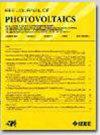Guard Ring Designs on Photovoltaic Energy Harvesting Silicon LSIs
IF 2.6
3区 工程技术
Q3 ENERGY & FUELS
引用次数: 0
Abstract
This study explores strategies for safeguarding complementary metal–oxide–semiconductor (CMOS) field-effect-transistors (FETs) and PN-diode against bulk carrier contamination for energy harvesting applications. Energy harvesting processes can generate excessive carriers within the bulk region, which can penetrate the PMOS region from the p(P-Sub)/n(NWell) junction or光伏能量收集硅lsi的保护环设计
本研究探讨了在能量收集应用中保护互补金属氧化物半导体(CMOS)场效应晶体管(fet)和pn二极管免受散货船污染的策略。能量收集过程可以在体区产生过多的载流子,这些载流子可以在没有三阱的情况下从p(p - sub)/n(NWell)结或nmosfet穿透PMOS区。为了解决这个问题,本研究研究了保护环结构通过重组其附近的载流子来保护cmos和pn二极管的有效性。未钝化金属在fet周围形成,在它们穿透pmosfet的NWell区或nmosfet本身之前,作为载流子消除的催化剂,从而改善了两个fet的关闭状态。对于PN二极管来说,获得的较小的断流和较低的阈值电压有利于低功耗。然而,这种保护环也会通过重新组合电池发电所需的载流子而降低光伏电池的性能。对PV电池w/back-surface-field (BSF)和w/o BSF的实验研究表明,前者降低了电池的$V_{\text{OC}}$,并且在PV电池附近形成保护环时需要谨慎。
本文章由计算机程序翻译,如有差异,请以英文原文为准。
求助全文
约1分钟内获得全文
求助全文
来源期刊

IEEE Journal of Photovoltaics
ENERGY & FUELS-MATERIALS SCIENCE, MULTIDISCIPLINARY
CiteScore
7.00
自引率
10.00%
发文量
206
期刊介绍:
The IEEE Journal of Photovoltaics is a peer-reviewed, archival publication reporting original and significant research results that advance the field of photovoltaics (PV). The PV field is diverse in its science base ranging from semiconductor and PV device physics to optics and the materials sciences. The journal publishes articles that connect this science base to PV science and technology. The intent is to publish original research results that are of primary interest to the photovoltaic specialist. The scope of the IEEE J. Photovoltaics incorporates: fundamentals and new concepts of PV conversion, including those based on nanostructured materials, low-dimensional physics, multiple charge generation, up/down converters, thermophotovoltaics, hot-carrier effects, plasmonics, metamorphic materials, luminescent concentrators, and rectennas; Si-based PV, including new cell designs, crystalline and non-crystalline Si, passivation, characterization and Si crystal growth; polycrystalline, amorphous and crystalline thin-film solar cell materials, including PV structures and solar cells based on II-VI, chalcopyrite, Si and other thin film absorbers; III-V PV materials, heterostructures, multijunction devices and concentrator PV; optics for light trapping, reflection control and concentration; organic PV including polymer, hybrid and dye sensitized solar cells; space PV including cell materials and PV devices, defects and reliability, environmental effects and protective materials; PV modeling and characterization methods; and other aspects of PV, including modules, power conditioning, inverters, balance-of-systems components, monitoring, analyses and simulations, and supporting PV module standards and measurements. Tutorial and review papers on these subjects are also published and occasionally special issues are published to treat particular areas in more depth and breadth.
 求助内容:
求助内容: 应助结果提醒方式:
应助结果提醒方式:


